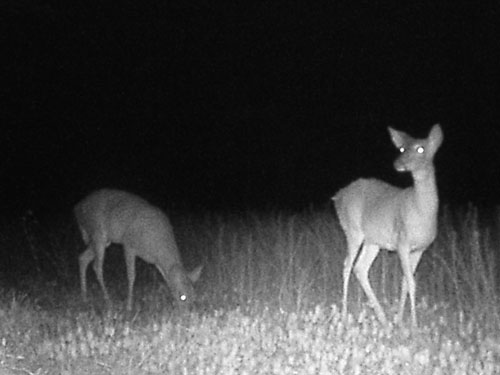
Trail cameras have a multitude of applications related to hunting, wildlife, and property management. A variety of models can produce daytime and night time photography and video.
Applications – Uses
Trail cameras are used for tracking and identifying wildlife in a variety of environments. Cameras are used by hunters for pre-hunt scouting or other research purposes. Hunters often employ trail cameras to monitor deer, bears, raccoons, coyotes, foxes, beavers, waterfowl, upland gamebirds, and other wildlife.
In addition to scouting game for hunting, trail cameras have numerous applications. They are frequently used for monitoring property, wildlife, or other activities that are not directly related to hunting.
Equipment and Accessories
Basic models include a power source (batteries), camera, motion sensor(s), LED panel display, SD card slot, USB port, enclosure, and instructions. Advanced models may include a cellular phone link may allow users to communicate or receive data from equipment in real time. In addition to cameras, users may need additional equipment such as spare SD cards, tripods, backpacks, or other items.
Camera Setup, Configuration, Testing
In order to achieve satisfactory results with a trail camera, preparation and proper setup of the equipment is important. Operators should begin by reading the user manual carefully in order to understand the equipment and its limitations.
Before entering the field, photographers should be familiar with equipment and perform setup, programming, and testing. If SD cards are used, users may need to properly install and format cards prior to use.
A good practice is to have at least two identical cards that will only be used in a single device. If multiple cameras will be installed in one location, each camera and card should be marked to avoid mixing equipment.
Trail Camera Locations
There are a number of factors to consider before choosing trail camera locations. For capturing photos of wildlife, trails are an obvious choice for locating equipment.
Food plots are sometimes monitored with trail cameras or other electronic equipment. Trail cameras can provide valuable information about wildlife activity related to plots or other properties.
Marshes provide numerous opportunities for monitoring wildlife. Trail cameras can be used to monitor waterfowl movements, feeding areas, nest boxes, and other activity.
Reviewing Photos and Videos
Reviewing imagery is a key step in the process. When possible, equipment should be checked after a day or more. A quick review of images in the field may provide important clues about the camera’s location and other factors. Often, an initial check will reveal minor problems that can be solved easily.
Once a camera is configured, mounted, and aimed properly, activity can be monitored over a period of days, weeks, or even months. Users may choose to visit cameras occasionally, swap SD cards, and check for any problems.
After a field trip is performed, images and/or videos can be viewed from a PC or other device. By saving and reviewing images over time, users can learn about about animal behavior, identify individuals, and other important information.